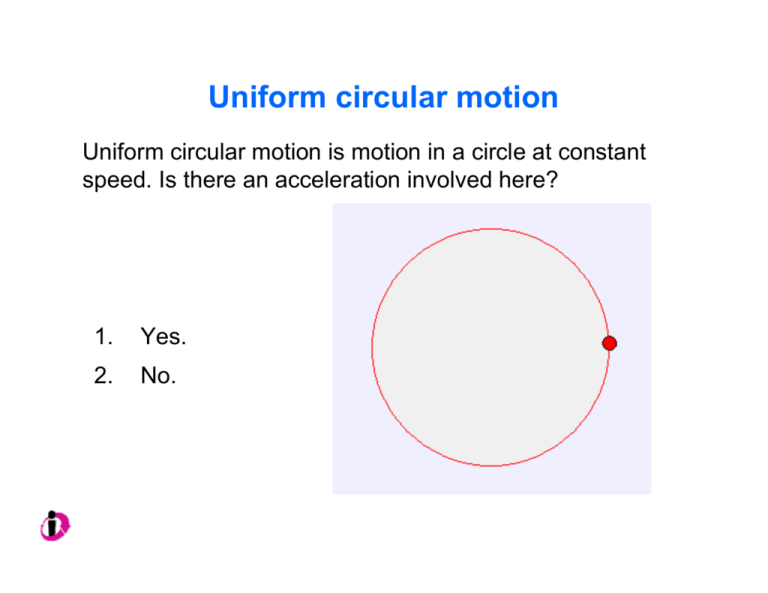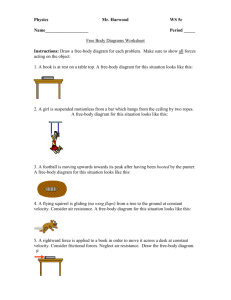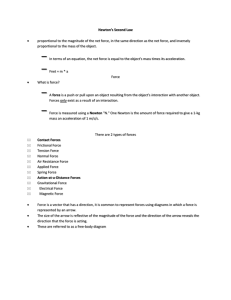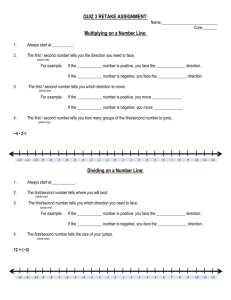PDF version of the PowerPoint presentation
advertisement

Uniform circular motion Uniform circular motion is motion in a circle at constant speed. Is there an acceleration involved here? 1. Yes. 2. No. Uniform circular motion Uniform circular motion is motion in a circle at constant speed. Is there an acceleration involved here? 1. Yes. 2. No. The object’s velocity is changing (its direction) so the object has a non-zero acceleration. Worksheet Let’s figure out what the acceleration depends on. Simulation The centripetal acceleration For uniform circular motion, the acceleration is directed toward the center of the circle. The magnitude is given by: v2 ac = r Uniform Circular Motion • The path is a circle (radius r, circumference 2πr). • “Uniform” means constant speed v = 2πr / T, where the period T is the time to go around the circle once. • Angle in “radians” ≡ (arc length ∆s) / (radius r) ∆θ = ∆s1/r1 = ∆s2/r2 is independent of the radius r of the circle, and is dimensionless Angular velocity Angular velocity ω ≡ ∆θ/∆t = 2π/T [rad/sec], is also independent of r Note that v = (2π/T)r = ω r [m/s], and therefore v is proportional to the radius of the circle. Cut the string A ball is whirled in a horizontal circle on the end of a string. When the string is released, which way does the ball go? Free-body diagram of the Earth Which free-body diagram of the Earth is correct? Fc stands for centripetal force, Fg for gravitational force. My personal opinion Don’t use the term “centripetal force” because that makes you think a magical new force pops up whenever something goes in a circle. We don’t need any new forces! The ones we already know about are sufficient. A general method for solving circular motion problems Follow the method for force problems! •Draw a diagram of the situation. •Draw one or more free-body diagrams showing all the forces acting on the object(s). •Choose a coordinate system. It is often most convenient to align one of your coordinate axes with the direction of the acceleration. •Break the forces up into their x and y components. •Apply Newton's Second Law in (usually) both directions. v2 The key difference: use a = r Disks on a turntable Two identical disks are placed on a flat turntable that is initially at rest. One disk is closer to the center than the other disk is. There is some friction between the disks and the turntable. We start spinning the turntable, steadily increasing the speed. Which disk starts sliding on the turntable first? 1. The disk closer to the center. 2. The disk farther from the center. 3. Neither, both disks start to slide at the same time. Disks on a turntable (see the worksheet) Sketch a free-body diagram for one of the disks, assuming it is not sliding on the turntable. Apply Newton’s Second Law, once for each direction. Disks on a turntable Sketch a free-body diagram (side view) for one of the coins, assuming it is not sliding on the turntable. FN FS Axis of rotation mg Can you tell whether the velocity is into or out of the screen? Disks on a turntable – force equations y-direction: FN y x FS x-direction: mg Disks on a turntable – force equations y-direction: v v ∑ Fy = may FN y x FS x-direction: mg Disks on a turntable – force equations y-direction: v v ∑ Fy = may +FN − mg = 0 FN y x FS x-direction: mg Disks on a turntable – force equations y-direction: v v ∑ Fy = may +FN − mg = 0 FN = mg FN y x FS x-direction: mg Disks on a turntable – force equations y-direction: v v ∑ Fy = may +FN − mg = 0 FN = mg x-direction: FN y x FS v v ∑ Fx = max mg Disks on a turntable – force equations y-direction: v v ∑ Fy = may +FN − mg = 0 FN = mg x-direction: FN y x FS v v ∑ Fx = max mv 2 +FS = r mg Disks on a turntable – force equations y-direction: v v ∑ Fy = may +FN − mg = 0 FN = mg x-direction: FN y x FS v v ∑ Fx = max mg mv 2 +FS = r As you increase r, what happens to the force of friction needed to keep the disk from sliding? Coins on a turntable Apply Newton’s Second Law, once for each direction. y-direction: FN − mg = 0 so that FN = mg x-direction: FS = max = m(v2/r) [both FS and a are to left] FN y x Axis of rotation FS mg As you increase r, what happens to the force of friction needed to keep the coin on the circular path? Can you tell whether the velocity is into or out of the screen? * * It is the same diagram and result either way! “Trick” question! v has a “hidden” dependence on r, so that the “obvious” dependence on r is not the whole story. The two coins have different speeds. Use angular velocity for the comparison, because the two coins rotate through the same angle in a particular time interval. v ω= so v = r ω r This gives: mv 2 mr 2ω 2 FS = = = mr ω 2 r r As you increase r, what happens to the force of friction needed to keep the coin staying on the circular path? “Trick” question! v has a “hidden” dependence on r, so that the “obvious” dependence on r is not the whole story. The two coins have different speeds. Use angular velocity for the comparison, because the two coins rotate through the same angle in a particular time interval. v ω= so v = r ω r This gives: mv 2 mr 2ω 2 FS = = = mr ω 2 r r As you increase r, what happens to the force of friction needed to keep the coin staying on the circular path? The larger r is, the larger the force of static friction has to be. The outer one hits the limit first. Simulation Verify the equation Spend the next 15-20 minutes working in groups, coming up with an experiment to show that the following is the correct form of the net force for uniform circular motion. Fnet mv = r 2 Conical pendulum A ball is whirled in a horizontal circle by means of a string. In addition to the force of gravity and the tension, which of the following forces should appear on the ball’s free-body diagram? 1. 2. 3. 4. 5. 6. A normal force, directed vertically up. A centripetal force, toward the center of the circle. A centripetal force, away from the center of the circle. Both 1 and 2. Both 1 and 3. None of the above. Conical pendulum (see the worksheet) Sketch a free-body diagram for the ball. Apply Newton’s Second Law, once for each direction. Conical pendulum (work together) Sketch a free-body diagram for the ball. Tsinθ θ Axis of rotation T θ y Tcosθ x mg Resolve Choose Apply Newton’s Second Law, once for each direction. x-direction: T sinθ = m(v2/r) y-direction: T cosθ = mg Solve: v2 tanθ = gr Gravitron (or The Rotor) In a particular carnival ride, riders are pressed against the vertical wall of a rotating ride, and then the floor is removed. Which force acting on each rider is directed toward the center of the circle? 1. 2. 3. 4. 5. A normal force. A force of gravity. A force of static friction. A force of kinetic friction. None of the above. Gravitron (see the worksheet) Gravitron simulation Sketch a free-body diagram for the rider. Apply Newton’s Second Law, once for each direction. Gravitron (work together) Sketch a free-body diagram for the rider. He’s blurry because he is going so fast! FS Axis of rotation FN mg y x Apply Newton’s Second Law, once for each direction. y direction: FS − mg = may = 0 (he hopes) x direction: FN = max = m (v2/r) Acceleration of the Earth What is the speed of the Earth as the Earth travels in its circular orbit around the Sun? What is the acceleration associated with this orbital motion? Acceleration of the Earth r = 150 million km = 1.5 × 1011 m T = 1 year ≈ π × 107 s 2π r 2π × 1.5 × 1011 m 4 v= = = 3 × 10 m/s 7 T π × 10 s ( 4 ) 3 × 10 m/s v2 = The acceleration is: ac = r 1.5 × 1011 m 2 = 0.006 m/s2 Uniform Circular Motion • The path is a circle (radius r, circumference 2πr). • “Uniform” means constant speed v = 2πr / T, where the period T is the time to go around the circle once. • Angle in “radians” ≡ (arc length ∆s) / (radius r) ∆θ = ∆s1/r1 = ∆s2/r2 is independent of the radius r of the circle, and is dimensionless • Angular velocity ω ≡ ∆θ/∆t = 2π/T [rad/sec], is also independent of r • Note that v = (2π/T)r = ω r [m/s], and therefore v is proportional to the radius of the circle. Vertical circular motion Our goal today is to understand various situations in which an object travels along a vertical circle. Examples • Water buckets • Cars on hilly roads • Roller coasters Ball on a string When a ball with a weight of 5.0 N is whirled in a vertical circle, the string, which can withstand a tension of up to 13 N, can break. Why? Where is the ball when the string is most likely to break? What is the minimum speed of the ball needed to break the string? Breaking the string A ball is being whirled in a vertical circle. Assuming the ball’s speed is constant, the string is most likely to break when the ball is … 1. At the top of the circle. 2. At the bottom of the circle. 3. Halfway between the top and the bottom of the circle. 4. Because the speed is constant, all points on the circle are equally likely for the string to break. Ball on a string – free-body diagrams Sketch one or more free-body diagrams, and apply Newton’s Second Law to find an expression for the tension in the string. At the top At the bottom Ball on a string – free-body diagrams Sketch one or more free-body diagrams, and apply Newton’s Second Law to find an expression for the tension in the string. Do the bottom first Assume same speed ma = mv2/r = 8N T=3N mg = 5 N (Actually, v will be smaller at the top) Breaks at T = 13 N ma = mv2/r mg = 5 N =8N when it breaks At the top At the bottom T + mg = mv2/r T – mg = mv2/r T = mv2/r – mg T = mv2/r + mg A water bucket As long as you go fast enough, you can whirl a water bucket in a vertical circle without getting wet. What is the minimum speed of the bucket necessary to keep the water in the bucket? The bucket has a mass m, and follows a circular path of radius r. If you go too slow, the string will go slack, and the water and the bucket will stay together along a parabolic free fall path. Free-body diagram for the water bucket Sketch a free-body diagram for the bucket (or the water), and apply Newton’s Second Law. Free-body diagram for the water bucket Sketch a free-body diagram for the bucket (or the water), and apply Newton’s Second Law. Ma = Mv2/r “Toward center” is down Mw g or Mb+wg FN on water, or T on bucket + water Mg + FN = Mv2/r But critical speed is when FN or T = 0 So Mg = Mv2min /r or vmin = (rg)1/2 Roller coaster On a roller coaster, when the coaster is traveling fast at the bottom of a circular loop, you feel much heavier than usual. Why? Draw a free-body diagram and apply Newton’s Second Law. Solve for the normal force applied on you by the seat. Solve for the normal force What is your expression for the normal force? 1. FN = mg 2. mv 2 FN = r mv 2 3. FN = mg + r mv 2 4. FN = mg − r mv 2 − mg 5. FN = r Roller coaster On a roller coaster, when the coaster is traveling fast at the bottom of a circular loop, you feel much heavier than usual. Why? Draw a free-body diagram and apply Newton’s Second Law. mv 2 +FN − mg = FN r mv 2 FN = mg + r The faster you go, the larger the normal force has to be. The normal force is equal to your apparent weight. ma = m(v2/r) mg Driving on a hilly road As you drive at relatively high speed v over the top of a hill curved in an arc of radius r, you feel almost weightless and your car comes close to losing contact with the road. Why? Draw a free-body diagram and apply Newton’s Second Law. Solve for the normal force. r Solve for the normal force What is your expression for the normal force? 1. FN = mg 2. mv 2 FN = r mv 2 3. FN = mg + r mv 2 4. FN = mg − r mv 2 − mg 5. FN = r Driving on a hilly road As you drive at relatively high speed v over the top of a hill curved in an arc of radius r, you feel almost weightless and your car comes close to losing contact with the road. Why? Draw a free-body diagram and apply Newton’s Second Law. mv 2 r mv 2 mg − FN = r mv 2 FN = mg − r mg FN Warning to drivers: Your braking is worst at the crest of a hill. Car loses contact when FN = 0 at v = (rg)1/2





